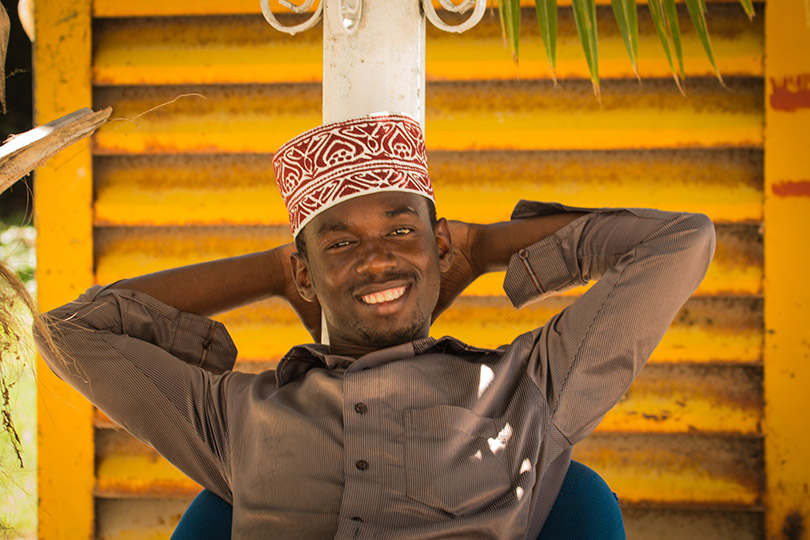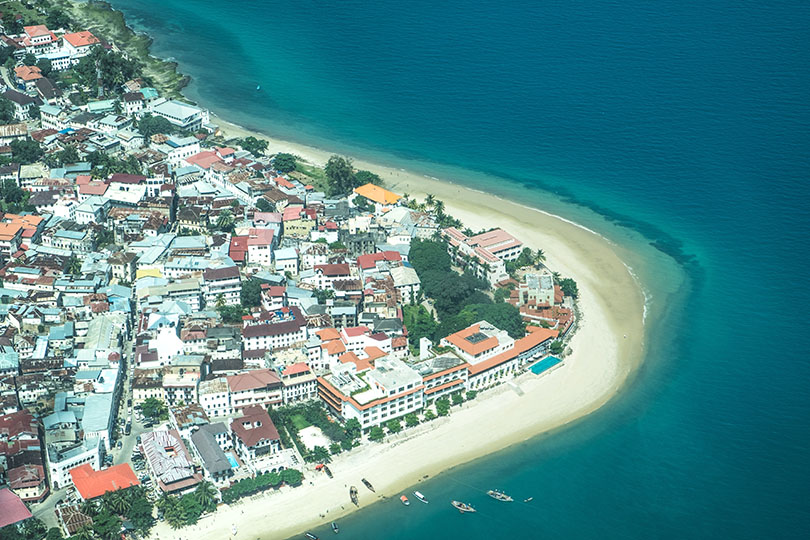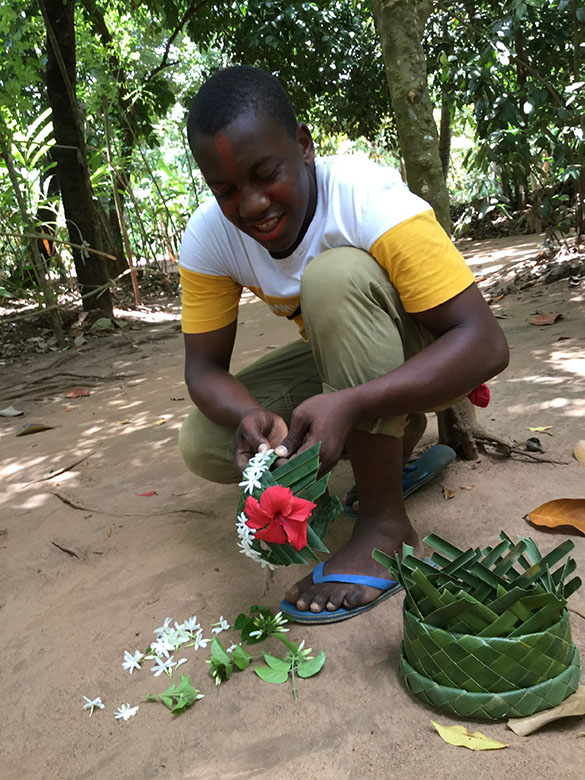PHOTOS: Chillin in Zanzibar; credit Cody McLain
Zanzibar
A First-Timer’s Guide to Zanzibar, Island Paradise of Tanzania
As you hot-foot it across the beach toward the Indian Ocean, what you see isn’t what you get. The squishy sand in the surf does soothe your toes. A little way out, the water looks deep enough to swim in. But if you take 10, then 20, and then 30 or 40 long strides toward the horizon, the water level still barely reaches your ankle.
On Zanzibar’s Paje Beach, low tide means no tide.
Why is that important? Because if you do an about-face at this distance, the shore looks like an iMax screen of white sands, waving palms, and aquamarine. On any other beach, such a wide panorama view could only be seen by doing some serious water-treading in some seriously deep water.
Offering these “only on this island” vistas, Zanzibar sits 40 miles off the coast of Tanzania in East Africa. Through its rich Arabic, Indian, and Portuguese history, the island serves up a blend of exotic cultures. You see it in the faces of the people, in the eclectic architecture, in the bright-hued artwork, and, especially, in the food.
Yes, you could spend your entire two weeks lazing on some of the most beautiful beaches in the world. But for a richer Zanzibar experience, don’t forget to:

One of many remarkably crafted Zanzibar doors; credit Patricia Hokororo
Step # 1 – Adore the Doors
Stone Town is the heart of Zanzibar City, the island’s capital. It’s an aptly named neighborhood where soaring concrete homes stand shoulder to shoulder in a maze of walkways. The massive doors are icons, teak, and mahogany structures more than eight feet tall and weighing as many as 600 pounds.
Intricate carvings, bold cutouts, and brass knobs decorate the surfaces. The artistic style speaks to the city’s multicultural history.
The doors’ conditions run the gamut – from grand to modest, shiny and polished to peeling and unwashed, meticulously well-kept and sadly ignored. You can book a tour of the neighborhood online (google “Zanzibar door tours”) or hire one of the many young men who’ll ask to escort you.
We decided to spend a morning wandering around on our own. We got lost in the most perfect way, flitting from door to door to admire the majesty of the designs. The highlight was finding the home of Freddie Mercury, the rock icon and lead singer of Queen. We happily waited our turn behind other fans to take a photo at the entrance to Freddie’s door.

Aerial view of Stones town, Zanzibar; credit Javi Lorbada
Step # 2 – Visit Stone Town’s Waterfront at Night
At dusk, tourists and locals gravitate to the waterfront, where they’ll find the best of island cuisine. Blazing daytime temperatures have cooled. The sun is slipping into the Indian Ocean. And the aroma of a thousand backyard cookouts hangs in the air at this night market, known as Forodhani Gardens.
Zanzibar pizza reigns supreme. The delicacy is part crepe, part omelet, a star of endless YouTube videos and travel bloggers. Curious onlookers line up to watch a blur of vegetable chopping, egg cracking, ground beef breaking, mayonnaise spreading, and finally, cooking on a hot grill. SmartPhones snap pics of the culinary action.
If pizza isn’t your thing, there are dozens of other food carts, offering sizzling sausages, beef, and chicken skewers, shawarmas of lamb wrapped in flatbread, fresh fish on ice. Point to a snapper, and it’s on the grill, then on your plate.
As for drinks, strong-muscled men insert sugarcane into a steel contraption and use brute force to rotate a lever that squeezes out sugar syrup used in the most refreshing of lemonades.

Arranging spices at the Spice Farm, Zanzibar; (c) Soul Of America
Step # 3 – Savor the Spices
Since Zanzibar is known as the spice island, you’re almost obligated to tour a spice farm. We visited Tangawizi. Rather than the acres upon acres of crops that I expected, the farm was more like a small park divided into sections devoted to individual spices.
Our guide led us past a dozen or more plants and bushes – including ginger, cardamom, cumin, saffron, turmeric, paprika, and cinnamon – offering five minutes of spice knowledge at each. He let us feel and smell the spice leaves or berries, described their origins, and gave an overview of how they’re used. His assistant, meanwhile, picked and braided low-hanging palm fronds into small cone-shaped baskets so we could carry the leaves and berries with us.
As we strolled along, the assistant picked and braided the fronds into souvenirs – hand fans, crowns, a bracelet and ring for me, and a necktie for Patrick.
We ran into a local young man wearing a Steph Curry jersey. He didn’t know anything about the Golden State Warriors but got a kick out of how excited we were. A Steph Curry sighting at a spice farm!
As you’d expect, we were able to buy packages of spices, as well as hand-made soap infused with their flavors.

Enjoying Zanzibar time at the beach; credit Antony
Step # 4 – Bask on the Beaches:
We initially took a pass on the beaches of Paje (pronounced Paw-JAY) on the island’s east coast. The city is a mecca for kite surfers, and we didn’t want to share the waves with hot-dogging daredevils. But, luckily, our cab driver talked us into staying at Paje’s Cristal Resort. We spent five blissful days and nights relaxing in a Corona Beer commercial.
Turns out the kitesurfing added to the experience. Bright, wide ribbons of red, yellow, and green kites sliced the sky, a colorful backdrop to the wild blue yonder.
Ask anyone about the beach scene in Zanzibar, and they’ll bring up the Massaai. Young warriors stroll the sands, swathed in the bright red patterned wraps we’re used to seeing them wear on TV nature shows, spears in hand.
“Hakuna Matata,” one will say in greeting. When you echo the greeting back, you’ll likely hear, “Ah, you speak Swahili.” Next comes pleasant conversation, ending with a request to view the souvenirs he carries in a canvas bag on his back.
We heard that young European women, especially Italians, visit Zanzibar specifically to hook up with the Massaai. It wasn’t uncommon to see an interracial couple walking hand-in-hand, he wrapped in a vibrant tribal cloth and she in a halter top and flip flops.
Like everyone else, they bask in the tropical sun and stroll across beaches that rival any you’d find in Hawaii or the Caribbean.
Back in Zanzibar City, we lazed on our balcony on the last morning, taking in a dawn waterfront scene:
A teenage boy strolled, hefting a red and white outdoor motor on his bare, muscled shoulders; joggers plodded along the otherwise deserted beach; a helmeted commuter on a fluorescent green motorbike vroomed by and a circle of women sat in a passing truck bed, their heads covered in hijabs of yellow, orange and blue and their laps cradling little ones. Next to them, two young men beat conga drums that echoed down the street.
It was a fitting kaleidoscope of images and sounds to cap our authentic Zanzibar adventure.
